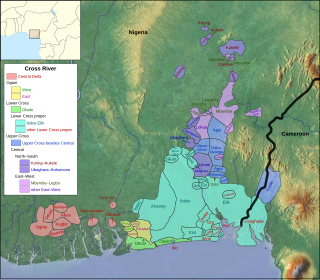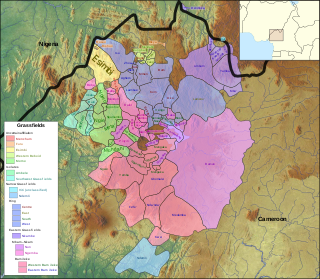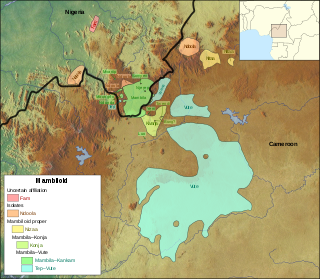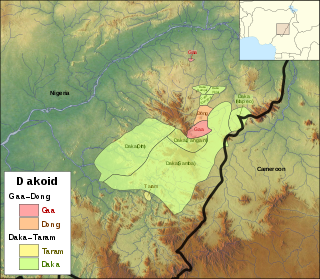Related Research Articles

Benue–Congo is a major branch of the Volta-Congo languages which covers most of Sub-Saharan Africa.

Southern Bantoid is a branch of the Bantoid language family. It consists of the Bantu languages along with several small branches and isolates of eastern Nigeria and west-central Cameroon. Since the Bantu languages are spoken across most of Sub-Saharan Africa, Southern Bantoid comprises 643 languages as counted by Ethnologue, though many of these are mutually intelligible.
Tiv is a Tivoid language spoken in some states in North Central Nigeria, with some speakers in Cameroon. It had over 5 million speakers in 2020. The largest population of Tiv speakers are found in Benue state in Nigeria. The language is also widely spoken in the Nigerian states of Plateau, Taraba, Nasarawa, Cross River, Adamawa, Kaduna, and Abuja. It is by far the largest of the Tivoid languages, a group of languages belonging to the Southern Bantoid languages

The Tivoid languages are a branch of the Southern Bantoid languages spoken in parts of Nigeria and Cameroon. The subfamily takes its name after Tiv, the most spoken language in the group.

There are over 525 native languages spoken in Nigeria. The Nigerian official language is English, the language of former colonial British Nigeria. As reported in 2003, Nigerian Pidgin was spoken as a second language by 60 million people in Nigeria.

The Beboid languages are any of several groups of languages spoken principally in southwest Cameroon, although two languages are spoken over the border in Nigeria. They are probably not most closely related to each other. The Eastern Beboid languages may be most closely related to the Tivoid and Momo groups, though some of the geographical Western Beboid grouping may be closer to Ekoid and Bantu.

The Cross River or Delta–Cross languages are a branch of the Benue–Congo language family spoken in south-easternmost Nigeria, with some speakers in south-westernmost Cameroon. The branch was first formulated by Joseph Greenberg; it is one of the few of his branches of Niger–Congo that has withstood the test of time.

The Grassfields languages are a branch of the Southern Bantoid languages spoken in the Western High Plateau of Cameroon and some parts of Taraba state, Nigeria. Better known Grassfields languages include the Eastern Grassfields languages Bamun, Yamba and the Ring language, Kom, Nso, Oku, Bali, Bafut. Almost all of these languages are closely related, sharing approximately half of their vocabulary.

The twelve Mambiloid languages are languages spoken by the Mambila and related peoples mostly in eastern Nigeria and in Cameroon. In Nigeria the largest group is Mambila. In Cameroon the largest group is Vute.
The Southwest Grassfields, traditionally called Western Momo when considered part of the Momo group or when Momo is included in Grassfields, are a small branch of the Southern Bantoid languages spoken in the Western grassfields of Cameroon.

The Dakoid languages are a branch of the Northern Bantoid languages spoken in Taraba and Adamawa states of eastern Nigeria.

The Bendi languages are a small group of languages spoken in Cross River State, southeastern Nigeria. Bokyi is one of the Bendi languages having some speakers in Cameroon. Once counted among the Cross River languages, they may be a branch of Southern Bantoid, with observed similarities especially with the Ekoid languages.
Daka is one of two languages spoken by the Chamba people in Nigeria, the other being Chamba Leko.
Mbe is a language spoken by the Mbube people of the Ogoja, Cross River State region of Nigeria, numbering about 65,000 people in 2011. As the closest relative of the Ekoid family of the Southern Bantoid languages, Mbe is fairly close to the Bantu languages. It is tonal and has a typical Niger–Congo noun-class system.
Batu is a Tivoid language of Nigeria. Dialects are Amanda-Afi, Kamino. Angwe was once assumed, but turns out to be a dialect of the divergent Buru language.
The Jagham language, Ejagham, also known as Ekoi, is an Ekoid language of Nigeria and Cameroon spoken by the Ekoi people. The E- in Ejagham represents the class prefix for "language", analogous to the Bantu ki- in KiSwahili

Fam is a Bantoid language of Bali LGA in Taraba State, Nigeria. It is now usually left as unclassified within Bantoid, however Blench (2011) classifies it as a divergent Mambiloid language potentially related to Ndoola.
Naki, or Munkaf, is an Eastern Beboid language of Cameroon and Nigeria. There is no name for the language; it is known by the villages it is spoken in, including Naki and Mekaf (Munkaf) in Cameroon and Bukwen and Mashi in Nigeria, the latter listed as separate languages by Ethnologue, though they are not distinct.
Iyive, also referred to as Uive, Yiive, Ndir, Asumbos, is a severely endangered Bantoid language spoken in Nigeria and Cameroon. The ethnic group defined by use of this language is the Ndir.
Northern Bantoid is a branch of the Bantoid languages. It consists of the Mambiloid, Dakoid, and Tikar languages of eastern Nigeria and west-central Cameroon.
References
- ↑ Buru–Angwe at Ethnologue (15th ed., 2005)

- ↑ Blench, Roger (2019). An Atlas of Nigerian Languages (4th ed.). Cambridge: Kay Williamson Educational Foundation.
- ↑ Roger Blench (15 September 2016). "The Tivoid languages: overview and comparative wordlist" (PDF). p. 14.